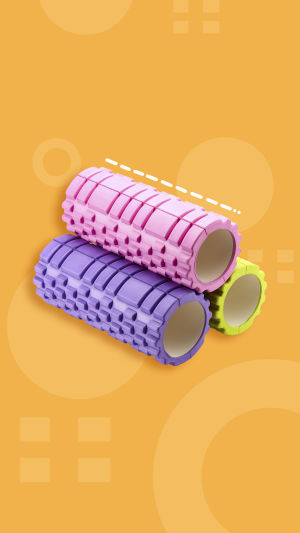Remember the excitement and nervousness when you first touched the roller massage? Believe that you are excited because you are about to join the ranks of fitness enthusiasts and start a healthy life.
And nervous because you know it will not be a smooth ride, and you may worry about buying the wrong tools for you, and even more doubts: How to use these tools? Will it hurt?
Will the time and effort invested pay off?
Maybe you may know a little about roller massage by now, but I believe you can be confused at times.
Fascia is a bundle of paper-like fibrous connective tissue hidden under the skin that wraps around the inside of the body like a spider web. Healthy fascia should be in a relaxed mesh state, like a relaxed body state.
When the fascia becomes tense and loses its elasticity, it creates pressure tightness that can make your body feel uncomfortable. Overuse, injury, or repetitive motion can all contribute to poor fascia health.
Roller massage is self-fascia relaxation therapy. Through rolling self-service massage, it can promote blood circulation, bring nutrients to fascia, and keep fascia healthy. The healthier the fascia, the better the mobility of the body.
Here are the top 5 myths about the strength, speed, timing and benefits of roller massage.
1. Does pain only work when using roller massage?
It is normal to feel pain when you first start the roller massage. When the muscles are relaxed, you will feel the relief of your body. At this point, you may want to increase the intensity of the massage, thinking that the harder it is, the better the effect.
However, this is a wrong notion.
Feeling pain is only part of using roller massage, but roller massage is not a pain-relieving exercise, and severe and unnecessary pain will not bring better results.
Conversely, applying too much pressure can cause muscles to become inflamed and parts of the body to be too stressed to repair themselves.
2. When using a roller, is faster the better?
no! Going too fast can keep the fascia from relaxing completely, because they are thick fibrous tissues and fast rolling won't relieve tension.
The correct way to do this is to press slowly, giving your fascia and muscles enough time to adjust to the pressure. The key is to figure out where the tension is and then roll and press slowly.
3. What is the most suitable rolling massage time?
Once you find the tight spot, roll and press for about 20 seconds, then move to another spot. 20 seconds per position is the ideal massage time. However, for some people, high-intensity and long-term massage may cause excessive pressure on the nerves, resulting in damage to the muscle tissue, resulting in bruising and even inflammation.
4. Can roller massage reduce muscle soreness and tightness?
That's right! Using a roller massage can improve blood circulation and speed up the delivery of body fluids to unhealthy fascia areas - blood is responsible for carrying nutrients and oxygen to various parts of the body, speeding up muscle repair, and body fluids are responsible for carrying away metabolic waste.
5. Can the roller massage be used on all parts of the body?
No, roller massage is not actually suitable for all parts of the body. For example, using a roller to massage the lower back can compress the spine, and at the same time, it is not easy to hold the roller in place on the lower back.
This action can also cause the back to bend excessively, causing strain.
Foam rollers have a wide range of applications, from calves, thighs, hamstrings, hip flexors, waist, abdomen, back, etc., almost everything you can get by rolling, can massage and relax the relevant muscles.
Foam rollers are also a very useful tool for runners. It works by loosening the fascia.
Tight fascia is one of the leading causes of pain in runners -- in fact, many injuries in the body are related to it -- even when not running. The best conventional method is massage, but the shortcomings are obvious.
First, it costs money, and it costs a lot to do it for a long time. Second, there are too few masseurs who really understand sports rehabilitation.
A foam roller is a cheap masseuse that works more than you can imagine. Especially after speed training and long-distance running, the stiff legs will be relaxed immediately.
So, every running you or strength training you should have a foam roller.





